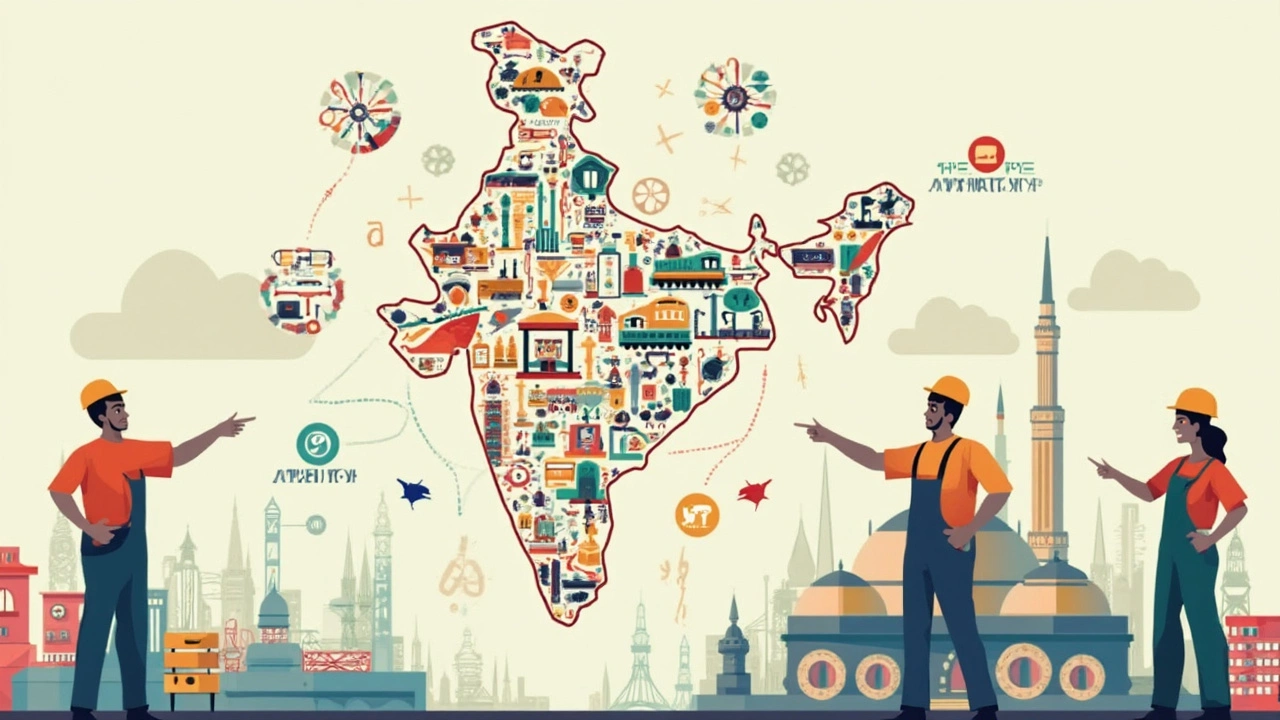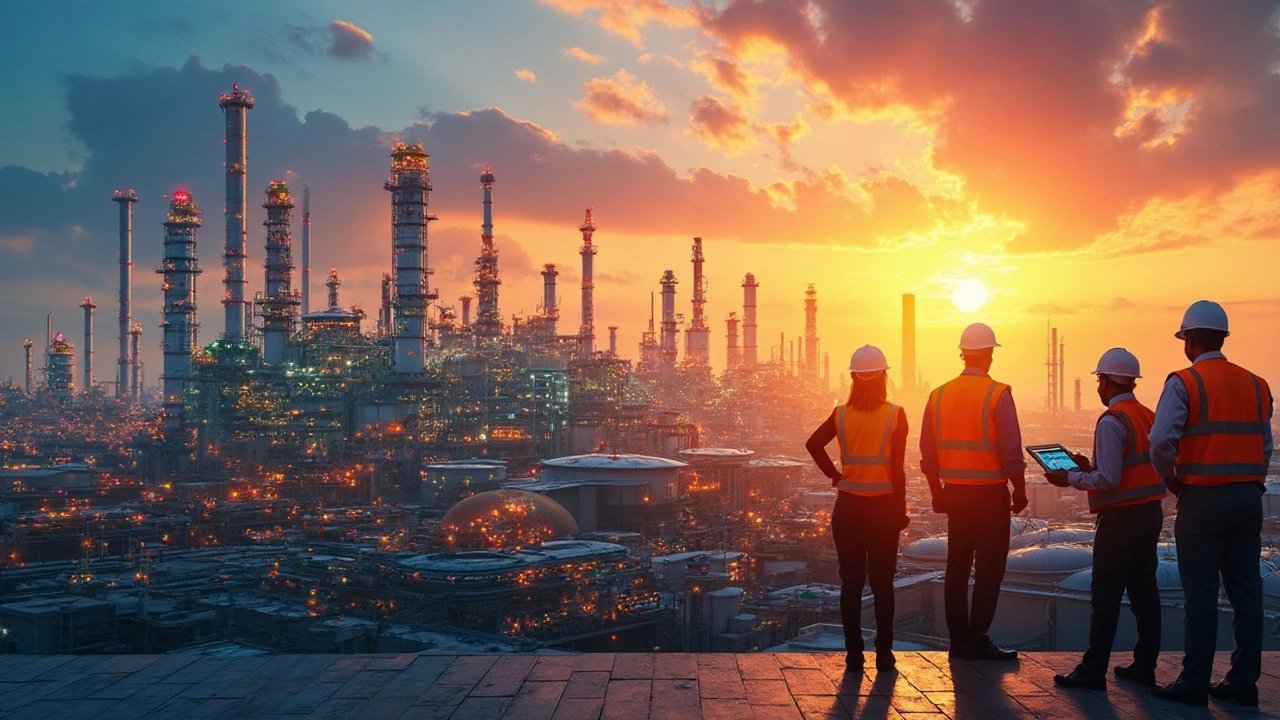Huge might be an understatement when you look at India’s chemical industry. In 2024, this sector shot past $220 billion in market value. And what’s wild? Experts believe it’ll double by 2025, which means the industry is on track to hit almost $400 billion. That’s not just big—it’s game-changing for India’s economy and for anyone curious about chemical manufacturing right here at home.
So why is this industry expanding so fast? The short answer is: India supplies everything from simple cleaning acids to advanced specialty chemicals, and it backs industries like textiles, pharma, agro, and food. Reliance Industries, Tata Chemicals, and Gujarat Alkalies are just a few big names driving the charge. Oh, and don’t think this growth stops at Indian shores—these companies export to over 175 countries.
No matter if you’re running a startup, scouting for manufacturing partners, or watching market trends for job opportunities—this sector isn’t slowing down. There’s a reason international giants are rushing to partner up or invest in Indian companies. If you want to tap into something booming, understanding the real size and reach of India’s chemical manufacturing scene can give you a big advantage.
- Mapping the Market Size: Numbers That Matter
- Key Segments Powering the Industry
- Exports, Imports, and Global Reach
- Tips for Businesses and Career Hunters
Mapping the Market Size: Numbers That Matter
If you’re wondering just how massive the Indian chemical industry is, check out the numbers. This sector is the sixth largest in the world and third in Asia, right behind big players like China and Japan. As of 2024, India's chemical industry is valued at an estimated $220 billion, and projections show it could hit close to $400 billion within a year or two if the momentum keeps up.
So, what’s fueling this growth? A few points really stand out:
- India is among the top 3 global producers for chemicals like alkalis, dyes, and agrochemicals.
- The sector supports more than 2 million people directly and much more through indirect jobs in transport, services, and supply chains.
- Domestic demand has skyrocketed thanks to population growth, urbanization, and rising incomes. It’s not just about exports—local industries, from plastics to pharma to textiles, need these chemicals every day.
To give you a clearer, at-a-glance view, here’s how things stack up:
| Year | Market Value (USD Billion) | Growth Rate (%) | Global Ranking |
|---|---|---|---|
| 2019 | 160 | 11 | 7th |
| 2022 | 200 | 11 | 6th |
| 2024 | 220 | 11.5 | 6th |
| 2025 (est.) | 400 | ~12 (projected) | 5th (projected) |
This isn’t just a bunch of big numbers for the sake of stats. The growth is steady and widespread. And believe it or not, more than 80,000 commercial products come out of this sector, from basic chemicals to the complex stuff used in high-tech industries. Startups and investors are also taking note—over $10 billion in fresh capital has flowed in during the last three years, especially in specialty and green chemicals.
If you’re looking to get involved or just track the pulse of Indian manufacturing, these numbers aren’t just trivia—they set the stage for real opportunities on the ground.
Key Segments Powering the Industry
The Indian chemical industry has a lot going on under the hood. It’s not just about big factories pushing out one product. We’re talking about everything from fertilizers to perfumes, plastics to paints. But a few segments pull the most weight and shape the market’s future.
Here’s where most of the action happens:
- Basic Chemicals (Bulk Chemicals): These are the building blocks—think acids, alkalis, solvents. They cover about 40% of the total production volume in India. If you’re working with anything industrial, odds are good it started here.
- Specialty Chemicals: This is the fastest-growing segment, rising at about 12% per year. It includes things like crop protection chemicals, paints, coatings, dyes, pigments, and additives—stuff that brings high value and unique properties.
- Petrochemicals: These fuel everyday life, from plastics to synthetic fibers. India’s capacity here is growing, especially as local producers cut down on imports from China. Around 25 million metric tons of polymers alone get produced annually.
- Agrochemicals: India is actually the world’s second-largest producer of agrochemicals after China. These products are vital for supporting our huge farming sector, from pesticides to fertilizers.
- Pharmaceutical Intermediates: The backbone of making many essential medicines. India supplies both domestic and global pharma players with chemicals needed to turn out finished drugs.
If you want a breakdown of how these segments stack up by size and growth rate, check out this snapshot:
| Segment | Market Share (%) | Growth Rate (CAGR %) |
|---|---|---|
| Basic Chemicals | 40 | 6 |
| Specialty Chemicals | 25 | 12 |
| Petrochemicals | 20 | 8 |
| Agrochemicals | 10 | 7 |
| Pharma Intermediates | 5 | 9 |
Specialty chemicals are especially hot right now—they’re versatile and needed in sectors that never stop growing, such as agriculture, textiles, and homecare. If you’re considering where to invest or build partnerships, this segment is worth a close look.

Exports, Imports, and Global Reach
If you line up India’s chemical exports, the numbers are impossible to ignore. As of 2024, Indian chemical manufacturers export products worth over $35 billion a year. Sounds huge? It is. That puts India among the top six chemical exporters worldwide. The biggest markets are the United States, China, Brazil, UAE, and Bangladesh. Here’s what’s interesting—India isn’t just sending out raw chemicals. It’s winning global contracts for specialty chemicals, dyes, and agrochemicals that need technical know-how.
And it’s not a one-way street. India also imports lots of chemicals, especially high-end specialty products and raw materials to keep local factories running. The annual chemical import bill is above $50 billion. This back-and-forth means Indian companies are plugged into global supply chains, which helps them keep up with the newest trends and tech.
What’s really driving India’s chemical industry on the world stage? Three things:
- Competitive prices thanks to low manufacturing costs
- A strong supply of talent (think chemical engineers and R&D pros)
- Growing reputation for delivering quality on tight deadlines
Pretty much every big chemical brand out there is working with or sourcing from India now. Even during tough global trade conditions, Indian exporters found ways to reach more than 175 countries. If you’re in the business, or looking to break in, remember this—exports and international collaborations are where the real action (and the most money) is right now for Indian chemical industry firms. It pays to keep an eye on what’s moving across borders, not just what’s happening locally.
Tips for Businesses and Career Hunters
Jumping into the Indian chemical industry isn’t just for big companies. Smaller businesses are grabbing market share, too. If you’re looking to work with or inside the industry, here’s what’s working now.
First, let’s look at some real facts.
| Opportunity | Key Fact |
|---|---|
| Specialty Chemicals | This segment is growing at 11% yearly, way faster than global averages. |
| Exports | India is the world’s 6th largest chemical exporter in volume as of 2024. |
| Job Creation | The sector employs more than 2 million directly, with new roles added every year. |
| Regulatory Push | New Production-Linked Incentive (PLI) schemes are attracting global investors and manufacturers. |
Now, here’s how smart businesses and job-seekers are staying ahead:
- Focus on specialty and green chemicals. Demand is shifting from basics to specialty segments like agrochemicals, pharma ingredients, and dyes.
- Stay compliant. The government’s stricter safety and environmental rules may sound tough but actually weed out unorganized competitors, leaving more space for those who do things the right way.
- Use digital tools. Chemical manufacturers India-wide are using automation and AI for better quality, cost efficiency, and faster scale-up.
- Don’t ignore networking. Conferences like ChemExpo India or CPhI India are places where business deals and job offers happen quickly. Get visible, pitch your strengths, and follow up.
If you’re job hunting, chemical engineers, process technologists, ESG analysts, and regulatory affairs pros are in hot demand. Upskill in safety, sustainability, and compliance. Many firms offer training or certifications, even online, so it’s easy to grab an edge.
And for entrepreneurs or businesses, India’s market has plenty of room for contract manufacturing, export partnerships, and new R&D. Working with a Indian chemical industry leader isn’t just about raw capacity—it’s also about global reputation, new technology, and regular government support. The trick is to pick your segment, build with compliance, and keep adapting as the industry shifts.

